I finally finished off my wool kirtle, which started out as the Lady with a Unicorn dress. It slowly evolved into something a bit different thanks to some mishaps with the pattern layout I was using and some over enthusiastic scissors. I am wearing it over my Tudor shift as I have yet to make a proper full chemise for it, the necklace is a small garnet and shall work as a place holder until I have time to make something else.
The Skirt:

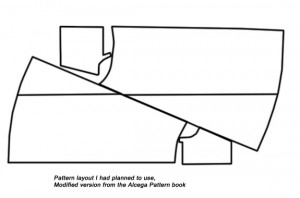
This is the pattern layout I had planned to use, it is from a later period but makes good use of fabric. Somewhere along the way I messed up on some math and the skirt was nowhere near full enough for me. So I went to add a panel but I can’t cut a straight line. (It’s a sickness I swear.)
So I ended up with a layout that looked more like the second drawing.
With a larger skirt then I planned, I wasn’t able to knife pleat it down to size, so despite the lack of paintings depicting it, I gathered the skirt to the bodice.
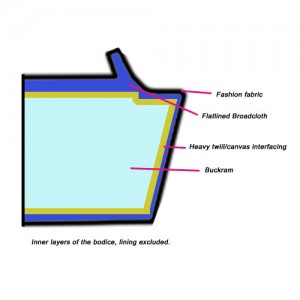
The Bodice
The bodice is a layer of wool, then a layer of broadcloth that has a layer of heavy twill with a layer of buckram quilted down to it, and a layer of cotton broadcloth lining. This was to further my experiments of not using boning. The buckram is prone to buckling and wrinkles at times but smooths out once the dress is fully laced in. In retrospect adding layer of wool felt would also help, something I plan to keep in mind for the next one I make.
The eyelets are made by hand, and after finishing them I finally got myself a proper awl. They are set to spiral lace up both sides. I lost some weight while making it, so I lace it differently to take it in.
The Sleeves
The sleeves are a hand dyed cotton velvet cut from from an old project and lined with gold satin, they are not as full as the sleeves in the painting but that also means they do not get in my way. The the bows are strips of thin stiff silk that I cut on the bias. Originally I made 6 tubes of velvet to tie the sleeves with but they ended up being too thick and chunky.
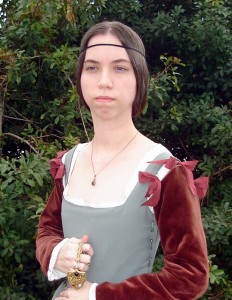


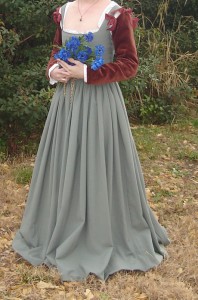

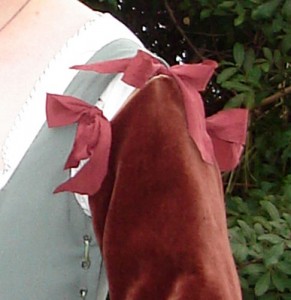
I do not sew….but I appreciate the art and work others put into it.
I had to chuckle when I read your line…I LOVE YOUR WRITING BTW..about something being pinned on w/ everyday sewing..pins? needles/..
When I was doing local theatre…about a hundred yrs ago… I preferred period pcs…15th-18th centuries….and was lucky enough to have a fabulous costumer….however..he was always caught up in so many other projects and ideas that when showtime arrived I was often “pinned into” my dresses/gowns…aware that at any moment a sharp stick in the side might be felt…so I was on edge more than I needed to be when on stage.
Once…actually my first costuming adventure with him …was for the bicentennial and an old script from the era had been hauled out…the gown..gorgeous..the paniers..painful-made from metal clothes hangers..and yes, I was pinned in from top to bottom…..
the play was performed at an outdoor amphitheatre…beautiful….however…during the first show, during the scene in which I was grabbed and lustily hugged a bazillion pins came undone, causing me to..well, not quite scream, but the yellow lab in the audience thought I was in danger and so charged the stage…happily there was an orchestra pit set below ground and the pooch couldn’t reach the stage itself.
Thanks, I’m glad you like it. I have some left over velvet so eventually I might make the bigger sleeves.
How accurate the gown is, is really for anyone to decide. It is made of wool, but I machine sewed most of it. It is lined with cotton rather then linen, the satin sleeve lining is acetate because that is what I had on hand. I based it off the Raphael painting, which is dated to 1505, but there is also some influence from other paintings and later eras. There is a nice gallery of images at:
http://www.festiveattyre.com/research/florentine/portfolio.html
The lack of boning in the bodice and the experiments with it is due to little evidence of boning being used then, nor the use of stays. It also means that the dress has to fit very well in order to give the right look. It may seem like a number of layers but it isn’t, with it being made up of wools and cottons I very comfortable.
First of all, the dress looks beautiful. I can’t wait until I can make dresses like that as well. Personally I would have liked bigger sleeves like in the painting though. Now they are like regular sleeves.
I have a few questions:
– How historically accurate would you call this dress? What period is it actually?
– Your experiments with the bodice, did they do it without boning then? Is that why you’re trying to do it without boning? I must have been very hot with all those layers.